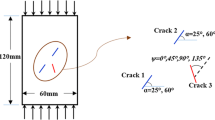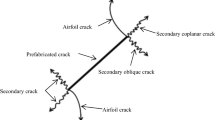The pre-cracked cylindrical specimens of rock-like materials are experimentally tested under compressive loading (using specially made rock-like specimens from portland pozzolana cement). The stress-strain and strength of the specimens are measured showing the decreasing effects of the cracks and their orientation on the final breakage stress of the specimen. The crack initiation and coalescence stresses during the crack propagation process are observed. The breakage process of the specimens is studied by inserting single and double cracks with different inclination angles at the center and applying uniaxial compressive stress at both ends of the specimen. The wing cracks are produced at the first stage of loading and start their propagation toward the direction of uniaxial compressive loading. The secondary cracks may also be produced in form of quasicoplanar and/or oblique cracks in a stable manner. The secondary cracks may eventually continue their propagation in the direction of the maximum principle stress. The same specimens are numerically simulated by an indirect boundary element method known as displacement discontinuity method. One may validate the results by the numerical and experimental results given in this study.




















Similar content being viewed by others
References
A. R. Ingraffea, “Fracture propagation in rock,” in: Z. P. Bazant (Ed.), Mechanics of Geomaterials: Rocks, Concretes, Soils, Ch. 12, John Wiley & Sons, Chichester, New York (1985), pp. 219–258.
H. Horii and S. Nemat-Nasser, Compression-induced microcrack growth in brittle solids: Axial splitting and shear failure, J. Geophys. Res., 90, 3105–3125 (1985).
O. Reyes and H. H. Einstein, “Failure mechanism of fractured rock – a fracture coalescence model,” in: Proc. 7th Int. Congress of Rock Mechanics, Vol. 1 (1990), pp. 333–340.
B. Shen, O. Stephansson, H. H. Einstein, and B. Ghahreman, “Coalescence of fractures under shear stress experiments,” J. Geophys. Res., 100, 5975–5990 (1995).
R. H. C. Wong and K. T. Chau, “Crack coalescence in a rock-like material containing two cracks,” Int. J. Rock Mech. Min. Sci., 35, 147–164 (1998).
C. C. Ke, C. S. Chen, and C. H. Tu, “Determination of fracture toughness of anisotropic rocks by boundary element method,” Rock Mech. Rock Eng., 41, 509–538 (2008).
E. Hoek and Z. T. Bieniawski, “Brittle rock fracture propagation in rock under compression,” Int. J. Fract. Mech., 1, 137–155 (1965).
Z. T. Bieniawski, “Mechanism of brittle fracture of rock. Pt. II. Experimental studies,” Int. J. Rock Mech. Min. Sci. Geomech. Abstr., 4, 407–23 (1967).
A. Bobet and H. H. Einstein, “Fracture coalescence in rock-type materials under uniaxial and biaxial compression,” Int. J. Rock Mech. Min. Sci., 35, 863–888 (1998).
A. Bobet and H. H. Einstein, “Numerical modeling of fracture coalescence in a model rock material,” Int. J. Fract., 92, 221–252 (1998).
J. F. Huang, G. L. Chen, Y. H. Zhao, and R. Wang, “An experimental study of the strain field development prior to failure of a marble plate under compression,” Tectonophysics, 175, 269–284 (1990).
R. H. C. Wong, K. T. Chau, C. A. Tang, and P. Lin, “Analysis of crack coalescence in rock-like materials containing three flaws – Part I: experimental approach,” Int. J. Rock Mech. Min. Sci., 38, 909–924 (2001).
E. Sahouryeh, A. V. Dyskin, and L. N. Germanovich, “Crack growth under biaxial compression,” Eng. Fract. Mech., 69, 2187–2198 (2002).
Y. P. Li, L. Z. Chen, and Y. H. Wang, “Experimental research on pre-cracked marble under compression,” Int. J. Solids Struct., 42, 2505–2516 (2005).
C. H. Park and A. Bobet, “The initiation of slip on frictional fractures,” in: 41st US Rock Mechanics Symposium, Paper 06–923, Golden, CO (2006).
C. H. Park and A. Bobet, “Crack initiation and propagation from frictional fractures,” in: Proc. of the 1st Canada–US Rock Mechanics Symposium (2007), pp. 557–564.
C. H. Park, Coalescence of Frictional Fractures in Rock Materials, Ph.D. Thesis, Purdue University, West Lafayette, IN (2008).
C. H. Park and A. Bobet, “Crack coalescence in specimens with open and closed flaws: A comparison,” Int. J. Rock Mech. Min. Sci., 46, 819–829 (2009).
C. H. Park and A. Bobet, “Crack initiation, propagation and coalescence from frictional flaws in uniaxial compression,” Eng. Fract. Mech., 77, 2727–2748 (2010).
S. Q. Yang, Y. H. Dai, L. J. Han, and Z. Q. Jin, “Experimental study on mechanical behavior of brittle marble samples containing different flaws under uniaxial compression,” Eng. Fract. Mech., 76, 1833–1845 (2009).
R. P. Janeiro and H. H. Einstein, “Experimental study of the cracking behavior of specimens containing inclusions (under uniaxial compression),” Int. J. Fract., 164, 83–102 (2010).
S. Q. Yang, “Crack coalescence behavior of brittle sandstone samples containing two coplanar fissures in the process of deformation failure,” Eng. Fract. Mech., 78, 3059–3081 (2011).
H. Lee and S. Jeon, “An experimental and numerical study of fracture coalescence in pre-cracked specimens under uniaxial compression,” Int. J. Solids Struct., 48, 979–999 (2011).
C. Pu and P. Cao, “Failure characteristics and its influencing factors of rock-like material with multi-fissures under uniaxial compression,” Trans. Nonferrous Met. Soc. China, 22, 185–191 (2012).
F. Erdogan and G. C. Sih, “On the crack extension in plates under loading and transverse shear,” J. Basic Eng., 85, Issue 4, 519–525 (1963).
M. A. Hussian, E. L. Pu, and J. H. Underwood, “Strain energy release rate for a crack under combined mode I and mode II,” in: Fracture Analysis, ASTM STP 560, Philadelphia, PA (1974), pp. 2–28.
G. C. Sih, “Strain-energy-density factor applied to mixed mode crack problems,” Int. J. Fract., 10, 305–321 (1974).
B. Shen and O. Stephansson, “Modification of the G-criterion for crack propagation subjected to compression,” Eng. Fract. Mech., 47, 177–189 (1994).
M. F. Marji, H. Hosseini Nasab, and A. H. Kohsary, “On the uses of special crack tip elements in numerical rock fracture mechanics,” Int. J. Solids Struct., 43, Issue 6, 1669–1692 (2006).
M. F. Marji and I. Dehghani, “Kinked crack analysis by a hybridized boundary element/boundary collocation method,” Int. J. Solids Struct., 47, Issue 7-8, 922–933 (2010).
M. F. Marji, “On the use of power series solution method in the crack analysis of brittle materials by indirect boundary element method,” Eng. Fract. Mech., 98, 365–382 (2013).
R. H. C. Wong, C. A. Tang, K. T. Chau, and P. Lin, “Splitting failure in brittle rocks containing pre-existing flaws under uniaxial compression,” Eng. Fract. Mech., 69, 1853–1871 (2002).
S. L. Crouch, Analysis of Stresses and Displacements around Underground Excavations: An Application of the Displacement Discontinuity Method, Geomechanics Report, University of Minnesota, Minneapolis, MN (1976).
H. Guo, N. I. Aziz, and R. A. Schmidt, “Linear elastic crack tip modeling by displacement discontinuity method,” Eng. Fract. Mech., 36, 933–943 (1990).
C. Scavia, “Fracture mechanics approach to stability analysis of crack slopes,” Eng. Fract. Mech., 35, 889–910 (1990).
M. H. Aliabadi and D. P. Rooke, Numerical Fracture Mechanics, Computational Mechanics Publications, Southampton, UK (1991).
H. Haeri, Numerical Modeling of the Interaction between Micro and Macro Cracks in the Rock Fracture Mechanism Using Displacement Discontinuity Method, Ph.D. Thesis, Department of Mining Engineering, Science and Research Branch, Islamic Azad University, Tehran, Iran (2011).
H. Haeri and A. K. Ahranjani, “A fuzzy logic model to predict crack propagation angle under disc cutters of TBM,” Int. J. Acad. Res., 4, No. 3, 159–169 (2012).
G. R. Irwin, “Analysis of stress and strains near the end of a crack traversing a plate,” J. Appl. Mech., 24, 361–364 (1957).
Author information
Authors and Affiliations
Corresponding author
Additional information
Translated from Problemy Prochnosti, No. 1, pp. 171 – 185, January – February, 2014.
Rights and permissions
About this article
Cite this article
Haeri, H., Shahriar, K., Marji, M.F. et al. On the Strength and Crack Propagation Process of the Pre-Cracked Rock-Like Specimens under Uniaxial Compression. Strength Mater 46, 140–152 (2014). https://doi.org/10.1007/s11223-014-9525-y
Received:
Published:
Issue Date:
DOI: https://doi.org/10.1007/s11223-014-9525-y




